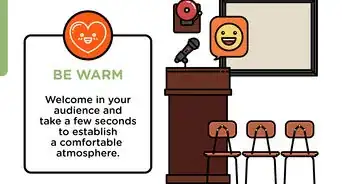This article was co-authored by Trudi Griffin, LPC, MS. Trudi Griffin is a Licensed Professional Counselor in Wisconsin specializing in Addictions and Mental Health. She provides therapy to people who struggle with addictions, mental health, and trauma in community health settings and private practice. She received her MS in Clinical Mental Health Counseling from Marquette University in 2011.
wikiHow marks an article as reader-approved once it receives enough positive feedback. This article received 12 testimonials and 92% of readers who voted found it helpful, earning it our reader-approved status.
This article has been viewed 157,599 times.
There will likely be times in your life when you will be working in a group, possibly many times. You may have to lead a discussion as part of a school assignment or you may be responsible for leading a discussion in a work setting. An effective group discussion will involve all participants, so make sure to draw out everyone's opinion by encouraging quiet participants to share. It is equally important that you value each member's opinion and all contributions by capturing what is communicated on paper as you go. Welcome new topics as they come up but be sure to direct the discussion toward some kind of conclusion. With a little knowhow and by being perceptive and proactive you can lead a great group discussion.
Steps
Beginning the Discussion
-
1Allow everyone to introduce themselves. To start a group discussion, you will want to make sure everyone is comfortable. A good way to break the ice is to let everyone introduce themselves. This way, you'll go into the discussion with everyone knowing everyone else a little bit.[1]
- You can go around the room and have everyone say their name. You may want each person to explain why they're participating in the discussion.
- For a classroom setting, an icebreaker activity may work well. You could, for example, have everyone share their favorite ice cream flavor.
-
2Establish some ground rules. Before launching into the discussion, make sure everyone knows the rules of conduct. You want to go into the discussion with boundaries for respect firmly established.[2]
- Advise everyone to treat one another with respect. Make it clear there should be no name-calling, personal attacks, or profanity. You can argue with someone's idea or opinion, but cannot argue with that person on a personal level.
- Make sure people know not to interrupt. Remind everyone the point of this discussion is for everyone to share equally.
- Remind everyone to be aware of time, and to make their points succinctly so everyone has the chance to share.
- Encourage people to consider their comments seriously, and to avoid becoming defensive if someone disagrees.
Advertisement -
3Explain the topic. Usually, a group discussion will be based around a central topic. Even if the participants know what that topic is, give them a quick refresher before the discussion begins.[3]
- You can introduce the topic by asking questions. For example, say something like, "Why are we all here?" This can be helpful if you're managing a conflict, or making plans for an event that are uncertain.
- You can also quickly introduce the idea. Say something like, "As you know, today in class we're going to discuss gun control."
-
4Ask open-ended questions to begin. You do not want to ask questions with a simple "yes" or "no" answer, especially not initially. Opening questions should not have a right or wrong answer, as this will push people to begin the discussion.[4]
- Your questions should encourage people to share meaningful thoughts and ideas. Questions can be confusing to the participants. Many participants may not know the answers right away themselves, encouraging them to think during discussion.
- For example, "What is it about our culture that contributes to gun violence? What are ways we can reduce the problem?" These questions are complicated, and have many potential answers.
Facilitating an Open Conversation
-
1Push towards new ideas when necessary. You can help move the discussion forward by introducing new ideas. If one party hits on an important point, you can interject to try to pick apart that idea more.[5]
- You want to make sure the discussion does not stay too long on one topic, so if you're lingering on one talking point, see what new ideas are being generated. When you hear a new potential idea, you can encourage the group to discuss this.
- For example, one student brings up the second amendment during the gun control debate. You have yet to really discuss the history and implications of that amendment. You can say something like, "Hey, I think Bryce made a great point. What about the second amendment? How does that affect our relationship with guns in the United States?"
-
2Ask participants follow-up questions. At first, people may give surface level answers to questions. If this is a problem, encourage people to open up more. After someone shares, ask a follow up question to encourage them to pick apart their opinion.[6]
- Follow up questions should usually be vague. For example, you can say something like, "Really? What makes you think that?" You can also say, "How do you feel about that fact?"
- Watch your tone. You want to sound friendly and inquisitive rather than authoritarian. If delivered in a harsh tone, "What makes you think that?" can sound like you disagree. When delivered in a light tone, you simply come off like you're curious to find new information.
-
3Encourage everyone to participate. Group discussions work well if everyone shares. Some participants may be hesitant to open up, so work on creating an environment where everyone feels comfortable sharing.[7]
- Breaking up into small groups for a moment can encourage more participation. You can tell the group to discuss the issue with the person next to them for 5 minutes. Then, you can re-assemble and ask everyone to share the discussions they had.
- You should also make it clear that everyone's opinion matters. Write everyone's comment on a white board. Encourage students to build on other people's comments. If a participant made a good point awhile ago, but has been silent for a bit, return to his or her point to move the discussion forward.
-
4Move the discussion forward as needed. Usually, you will have some kind of agenda for a group discussion. You want participants to reach some kind of conclusion, agreement, or insight. As the discussion continues, work to move it towards a conclusion.[8]
- Keep asking questions throughout the discussion. In addition to asking participants a question, ask questions of the group that complicate the issue.
- For example, "While we all disagree on what the second amendment means, how much does that matter? Culturally, people interpret it in a specific way. Does the cultural interpretation matter more than the literal meaning?"
- Push participants for clarification. Getting more insight out of an opinion can help introduce new ideas, leading to new insight for the discussion. For example, "I understand you feel banning automatic weapons would decrease gun violence, but can you tell me more about what makes you feel that way?"
-
5Wrap up the discussion. You should review the discussion briefly when it reaches its end. What has everyone learned? Have you reached any conclusions?[9]
- Make sure everyone understands the key points made. You can say something like, "I'm hearing half of you feel that we have the right to own guns for protection, while half of you feel there should be heavier restrictions."
- Have the group review the discussion from here. Ask open ended questions that will lead the group to reflect on what everyone learned. For example, "Have your opinions on gun control changed? Leaving this classroom, how do you think you'll discuss the issue in the future?"
Handling Problems
-
1Avoid letting one person or group of people dominate. Oftentimes, you get a mixed group. Some people are shy and withdrawn, while others are not. The more outgoing members can sometimes dominate a discussion, and you want to make sure everyone gets a chance to share.[10]
- If one group has been bringing up the same point for awhile, try to cut it off in a respectful manner. For example, "I think those issues are important, but I want to make sure we give time to other factors surrounding this debate."
- Try to bring the discussion back to the shy people. For example, "Lucy made up an interesting point earlier. Maybe we could revisit that."
-
2Deal with a participant who talks too much. Sometimes, it is a single person who is very assertive and tends to dominate the conversation. Even if this person is making good points, it's important you not let a single person dominate.[11]
- Try asking the talkative person to act as an observer for a few minutes. For example, "John, you seem to have strong opinions. Why don't you just observe for a few minutes. Take notes on the discussion. You can share these later, and we can see how the discussion shaped your opinions."
- You can also try to use the dominant person's input to steer the conversation in a new direction. For example, "John has brought up conceal and carry laws several times, and seems quite passionate about this. Let's talk for a bit about why people feel strongly about such laws."
-
3Smooth over conflict. If you're dealing with a sensitive subject especially, people may get angry. If a conversation starts to become confrontational or tense, find ways to break up the tension.
- Ask people arguing to back up their opinions using outside authority. This will cause the discussion to become more objective and less personal.
- Ask people to be aware of differences in values. Say something like, "I feel like the two of you share different values. Can we talk about that?"
- You can also list both sides of the argument on the board. Encourage participants to continue to debate the point, but in a respectful manner. Say something like, "I think we should talk about this, as we all feel strongly, but let's take turns examining each other's points respectfully."
-
4Help shy participants share their opinions. Sometimes, the smartest participants are the most shy. You want to make sure those who feel uncomfortable sharing do so. It's important to hear everyone's thoughts.[12]
- You can ask the shy participant directly. For example, "Molly, why don't you tell us how you feel?"
- You can also have everyone write down their answers to a question and then share. A nervous participant may feel more comfortable sharing if they have their idea written down.
References
- ↑ https://www.brown.edu/sheridan/teaching-learning-resources/teaching-resources/classroom-practices/learning-contexts/discussions/tips
- ↑ http://ctb.ku.edu/en/table-of-contents/leadership/group-facilitation/group-discussions/main
- ↑ http://ctb.ku.edu/en/table-of-contents/leadership/group-facilitation/group-discussions/main
- ↑ https://www.eiu.edu/ihec/Krueger-FocusGroupInterviews.pdf
- ↑ http://ctb.ku.edu/en/table-of-contents/leadership/group-facilitation/group-discussions/main
- ↑ https://www.brown.edu/sheridan/teaching-learning-resources/teaching-resources/classroom-practices/learning-contexts/discussions/tips
- ↑ https://www.lds.org/ensign/2016/02/conducting-a-well-tuned-group-discussion?lang=eng
- ↑ http://ctb.ku.edu/en/table-of-contents/leadership/group-facilitation/group-discussions/main
- ↑ https://www.eiu.edu/ihec/Krueger-FocusGroupInterviews.pdf
- ↑ http://ctb.ku.edu/en/table-of-contents/leadership/group-facilitation/group-discussions/main
- ↑ https://www.brown.edu/sheridan/teaching-learning-resources/teaching-resources/classroom-practices/learning-contexts/discussions/tips
- ↑ https://www.canr.msu.edu/news/how-to-effectively-manage-the-talkative-and-silent-members-of-a-group
About This Article
To conduct a group discussion, start by having everyone introduce themselves. Next, establish some ground rules, like treating everyone with respect, no interrupting, and being succinct. Then, explain the topic that’s up for discussion and ask an open-ended question to begin the conversation. As you facilitate the conversation, you may want to interject to point out particularly good points or redirect the dialogue if it’s going too far off track. You can also ask follow-up questions to help participants think more deeply about their claims. To learn how to encourage everyone to participate, keep reading!











































































